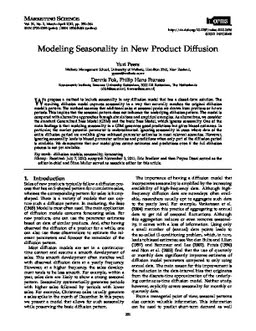2012-03-01
Modeling seasonality in new product diffusion
Publication
Publication
Marketing Science: the marketing journal of INFORMS , Volume 31 - Issue 2 p. 351- 364
We propose a method to include seasonality in any diffusion model that has a closed-form solution. The resulting diffusion model captures seasonality in a way that naturally matches the original diffusion model's pattern. The method assumes that additional sales at seasonal peaks are drawn from previous or future periods. This implies that the seasonal pattern does not influence the underlying diffusion pattern. The model is compared with alternative approaches through simulations and empirical examples. As alternatives, we consider the standard Generalized Bass Model (GBM) and the basic Bass Model, which ignores seasonality. One of the main findings is that modeling seasonality in a GBM generates good predictions but gives biased estimates. In particular, the market potential parameter is underestimated. Ignoring seasonality in cases where data of the entire diffusion period are available gives unbiased parameter estimates in most relevant scenarios. However, ignoring seasonality leads to biased parameter estimates and predictions when only part of the diffusion period is available. We demonstrate that our model gives correct estimates and predictions even if the full diffusion process is not yet available.
| Additional Metadata | |
|---|---|
| , , | |
| doi.org/10.1287/mksc.1110.0696, hdl.handle.net/1765/37573 | |
| ERIM Top-Core Articles , Econometric Institute Reprint Series | |
| Marketing Science: the marketing journal of INFORMS | |
| Organisation | Erasmus Research Institute of Management |
|
Peers, Y., Fok, D., & Franses, P. H. (2012). Modeling seasonality in new product diffusion. Marketing Science: the marketing journal of INFORMS, 31(2), 351–364. doi:10.1287/mksc.1110.0696 |
|

